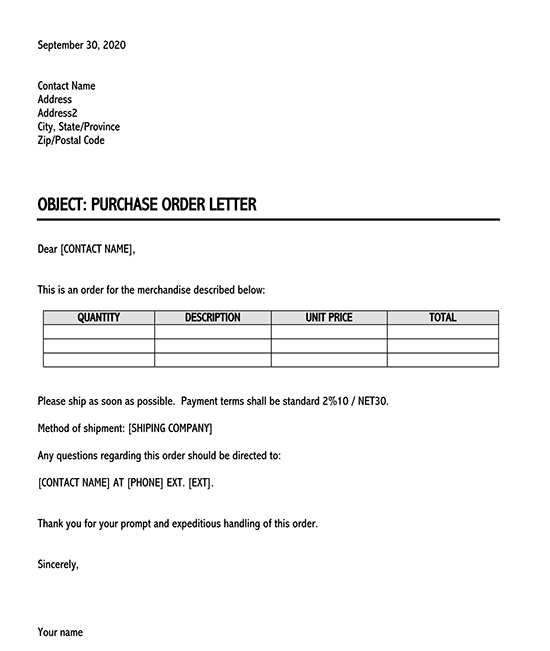
The order consists of an orientation and five paragraphs. The five paragraphs are: Situation, Mission. Execution, Administration and Logistics, and Command and Signal. Again, this format is commonly referred to and remembered by the acronym SMEAC An operation order is “a directive issued by a commander to subordinate commanders for the purpose of effecting the coordinated execution of an operation.” Commanders at all echelons use them. They Jul 22, · Many people find it easier to make an order to show cause because the court sets the court date and tells you how to deliver the papers to the other side. An order to show cause is good to use in an emergency situation. It can often get you into court faster than a motion
How to Write Order Letter- Order letter Example & Samples
Given an operations order or a mission and considering the situation, unit capabilities, and time available, issue a five paragraph order to communicate a basic, realistic, and tactically sound plan. Without the aid of references, identify elements contained within the Orientation paragraph of a five paragraph order without omission. OCS-PAT- a 2. Without the aid of references, identify elements contained within the Situation paragraph of a five paragraph order without omission.
OCS-PATb 3. Without the aid of references, identify elements contained within the Mission paragraph of a five paragraph order without omission.
OCS-PATc 4. Without the aid of references, identify elements contained within the Execution paragraph of a five paragraph order without omission. OCS-PATd 5. Without the aid of references, identify elements contained within the Administration and Logistics paragraph of a five paragraph order without omission. OCS-PATe 6. Without the aid of references, identify elements contained within the Command and Signal paragraph of a five paragraph order without omission.
OCS-PAT f 7. Without the aid of references, utilize techniques of issuing an order to deliver a five-paragraph order to subordinates. Six Steps Of Troop Leading Procedures BAMCIS. To plan the use of our time, we use reverse planning.
Start with the last action for which time is given, i, writing an order. time of attack, and work backward. A warning order, which we will discuss later, will often be issued at the start of our planning process. This allows unit members to prepare for the upcoming operation. We use METT-T to do an estimate of the situation and come up with a course of action. We receive this information from highers order and by studying our map. a Mission: What is your mission from higher, who.
what, when, where, and why. b Enemy: Use the information from Enemy Forces under Situation to analyze your opponent. c Terrain and Weather: May be given in Orientation; if not, what is it like outside now, over the last hours.
How will the weather effect us and the enemy, writing an order. The acronym KOCOA helps to identify aspects of terrain and weather that could offer advantages or disadvantages to either friendly or enemy forces. KOCOA stands for Key Terrain, Observation and fields of fire, Cover and concealment, Obstacles, and Avenues of approach.
d Troops and fire support available: Drawn from highers order and outlines what your troop strength will be, to include fire support assets available to you. e Time: How much time do you have available for planning, execution? At OCS, this step will not be conducted, writing an order. It is the unit leaders responsibility to complete the plan in a timely fashion.
This will be the final order issued for the mission. Supervision is writing an order and occurs throughout the entire combat orders process for a mission.
The writing an order leader for that mission is ultimately responsible and accountable for mission accomplishment. Though there arc many different types of orders Attack, Patrol, etc. All orders should have this same basic format. They all follow the 5 paragraph order format. The difference will usually be a greater level of detail in different areas of the order. The order consists of an orientation and five paragraphs, writing an order.
The five paragraphs are: S ituation, M ission. E xecution, A dministration and Logistics, and C ommand and Signal. Again, this format is commonly referred to and remembered by the acronym SMEAC.
Outlined below is the format used for the combat orders process. At the company level and below, orders are most commonly issued orally with the aid of a terrain model. Prior to issuing an order, the unit leader orients his subordinate leaders to the planned area of operation using a terrain model, writing an order, map, or when possible, the area of operation. The purpose of the orientation is to simply orient subordinates prior to issuing the order.
Keep the orientation simple and brief. The orientation should include:. Present location eight digit grid Direction of attack Cardinal Direction, ex. Northeast, Southwest Location of the objective eight digit grid. The situation paragraph contains information on the overall status and disposition writing an order both friendly and enemy forces. The situation paragraph contains three subparagraphs: Enemy Forces, Friendly Forces, Attachments and Detachments, writing an order.
Enemy Forces, writing an order. Information about the enemy contained in this subparagraph should be the culmination of intelligence provided by higher headquarters and information gathered which pertain to the accomplishment of the mission. The Enemy Forces situation can be issued using the acronyms SALUTE and DRAW-D. This information should highlight what course of action the enemy will most likely execute upon contact.
DRAW-D represents: Defend, Reinforce, Attack, Withdraw, and Delay. There is no requirement to mention every course of action the enemy might possibly take, only the one that is most likely. The are amred with semi-automatic weapons and have communications gear. They are expected to withdraw upon contact.
Friendly Forces. It contains the missions and locations of higher, adjaccnt, and supporting units. Information should be limited to that which subordinate leaders need to know to accomplish their assigned mission. The Friendly Forces situation can be issued using the acronym HAS, which represents:.
The mission and location of units to your left, right, front and rear having effect on your mission. Nonorganic units providing combat support or combat service support are addressed here. The mission statement is a clear and concise statement one simple sentence of what the unit is assigned to accomplish.
The task describes the action to be taken while the purpose describes the desired result of the action. Of the two, the purpose Why is predominant. The purpose of the mission statement is always represented by the words: in order to and writing an order be abbreviated by IOT.
While the situation may change, making the task obsolete, the purpose is more permanent and continues to guide actions. fire team assigned the most important task to be accomplished by the higher unit e. The commander ensures the success of the main effort by providing it with a preponderance of support i.
The information in this paragraph is generated by the unit leader issuing the order. Subordinate unit leaders must generate their writing an order Execution Paragraph outlining their plan to accomplish their mission.
This is the part of the order that ties the mission statement and the concept of the operation together your mission with your plan to accomplish it. Concept of the Operation.
The concept of operation includes two subparagraphs: Scheme of Maneuver SOM and Fire Support Plan FSP. Writing an order subordinate unit tasks have not been identified, then none of the fireteams will know who is doing which specific part of the entire plan and will be forced to listen on what the whole squad is doing.
For an offensive operation the scheme of maneuver includes: form of maneuver, writing an order, initial formation, attack formation, assault formation and the basic plan for consolidation and reorganization. Describes how fire support will be used to complement the scheme of maneuver. The Fire support plan writing an order in directly with the scheme of maneuver.
The initial formation should be squad column, writing an order, fire team wedge. Writing an order attack formation should be squad wedge, fire team wedge. The assault formation should be squad on line, fire team skirmishers right or left. After consolidating meters past the objective, form a hasty ISO and prepare for enemy counterattack. When writing an order that there is no chance of enemy counterattack, consolidate into a around the objective, assign overlapping sectors of fire, gather ACE Reports from fire team leaders and report to higher.
The specific missions to be accomplished by each subordinate element of the unit will be listed in a separate numbered subparagraph. Coordinating Instructions. Coordinating instructions are those specific instruction that tie the plan together. Inclucded are details of coordination and control applicable to two or more units in the command, writing an order.
Items commonly addressed in coordinating instructions include:. The designated time to cross the line of departure. This term and the Main Effort can be synonymous. a Assembly Area to Attack Position : Example: Squad writing an order, fire team wedge, order from front to back is 1st fireteam, 2nd fireteam, then 3rd fireteam.
b Attack Position to Assault Position : Example: Squad wedge, fire team wedge, order from left to right is 1st fireteam, 2nd fireteam, then 3rd fireteam. c Assault Position to Objective : Example: Squad on line, fire team skirmishers right, writing an order, order from left to right is 1st fireteam, 2nd fireteam, then 3rd fireteam.
5 Basic Rules of Writing Kanji
, time: 4:38The Operation Order (OPORD)

Jul 22, · Many people find it easier to make an order to show cause because the court sets the court date and tells you how to deliver the papers to the other side. An order to show cause is good to use in an emergency situation. It can often get you into court faster than a motion Nov 20, · 1. Order of movement, formations, and movement techniques. Use a sketch/terrain model. 2. Actions at halts (short/long). – SOP. 3. Routes (primary/alternate). – Give the hard azimuth and distance. 4. Departure and reentry of friendly lines. 5 Tips before Writing an Order Letter: The letter should be very precise, there is no pep talk or casual talking required here. The language should be easy while also being formal. Do not make any mistakes in the specifications and quantities. Avoid spelling and grammatical errors. Stick to the topic
No comments:
Post a Comment